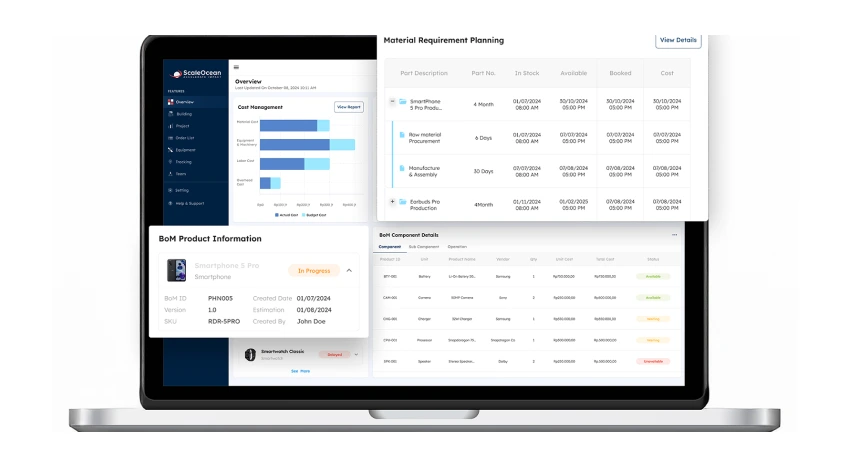Understanding Cost of Goods Sold (COGS) is important for businesses that want to maximize profits while maintaining accurate financial records. COGS refers to the direct costs of producing goods or services, which include raw materials, direct labor, and manufacturing costs. Managing these costs effectively can have a significant impact on a company’s bottom line.
According to IBISWorld, the manufacturing sector in the US has experienced a compound annual growth rate (CAGR) decline of 0.4% over the past five years, reaching an estimated $7.0 trillion in 2024. Proper COGS calculation and analysis assists companies in setting competitive prices, managing inventory efficiently, and making sound financial decisions. This article focuses on the fundamentals of COGS, including its definition, essential components, and distinctions from other financial indicators, offering significant insights for business owners and financial managers.

What is COGS?
Cost of Goods Sold (COGS) is an important financial indicator that indicates the direct costs associated with producing the goods or services that a company sells. It comprises expenses such as raw materials, labor, and production overhead. Overhead costs, unlike COGS, are necessary to run the business but are not directly tied to production. COGS is critical for calculating gross profit because it is deducted from revenue to determine profitability.
Businesses can use COGS analysis to optimize pricing strategies, control production costs, and improve operational efficiency. Accurate COGS tracking is important for financial health, as it leads to better decision-making and business success.
Why Is Cost of Goods Sold (COGS) Important?
The Cost of Goods Sold (COGS) is important because it directly impacts a company’s profitability by determining the cost to produce or acquire the goods sold. COGS helps businesses calculate gross profit by subtracting it from total revenue, giving insights into overall financial health.
A clear understanding of COGS enables companies to set competitive pricing, manage production costs, and optimize operational efficiency. By tracking COGS accurately, businesses can identify cost-saving opportunities, maintain healthy profit margins, and make informed strategic decisions. Proper COGS analysis also ensures accurate tax reporting and financial transparency, critical for long-term business sustainability.
What Is the Cost of Goods Sold (COGS) Formula?
The Cost of Goods offered (COGS) formula is a simple calculation used to quantify the direct expenses of manufacturing goods or services offered by a company. The formula is:
COGS = Beginning Inventory + Purchases During the Period – Ending Inventory
Beginning inventory represents the value of goods available at the start of a period, while purchases account for additional inventory acquired. Ending inventory reflects unsold goods at the period’s close. To determine production costs, start with beginning inventory, add purchases, and subtract ending inventory.
This calculation offers a clear view of production expenses, enabling businesses to assess profitability, optimize inventory management, and make informed financial decisions. By maintaining accurate records, companies can improve cost control, streamline operations, and ensure a more efficient approach to financial planning.
Also read: What is Material Requirement Planning (MRP) and Its Benefits
How do you Analyze the Cost of Goods Sold?

Understanding the Cost of Goods Sold (COGS) is essential for determining a business’s profitability. An accurate analysis enables businesses to control costs, fine-tune pricing tactics, and improve financial planning. The following points explains the important processes for assessing COGS.
1. Understanding the Components of COGS
COGS includes direct costs associated with producing goods or services, such as raw materials, labor, and manufacturing expenses. Excluding indirect costs like marketing and distribution ensures accurate calculations. A clear breakdown helps businesses track spending patterns and identify areas for cost reduction.
2. Calculating COGS Using the Right Formula
The Cost of Goods Sold is calculated by adding the beginning inventory to purchases made during the period and then subtracting the ending inventory. This calculation reveals the actual cost of production for a specific time frame. To ensure accuracy, it’s important to apply proper inventory valuation methods, such as FIFO or LIFO, which help prevent financial discrepancies and support better decision-making.
3. Identifying Cost Trends and Variations
COGS trends are analyzed on a regular basis to uncover inefficiencies, pricing fluctuations, and seasonal changes in manufacturing costs. By comparing historical data to current information, organizations may improve supplier contracts and production processes. Identifying cost fluctuations allows for better budget control and improved profit margins.
4. Enhancing COGS Efficiency Through Cost Management
Reducing COGS requires efficient supplier negotiations, lean inventory management, and process automation. Businesses should implement cost-saving strategies without compromising product quality. A streamlined supply chain, machine availability, and waste reduction initiatives help maintain competitive pricing while improving overall profitability.
What Is Included in the Cost of Goods Sold (COGS)?
All direct expenses associated with producing goods or services are included in the Cost of Goods Sold (COGS). Recognizing its components allows businesses to monitor profitability, refine pricing strategies, and efficiently manage financial performance. The following are the key elements that constitute COGS and their impact on a company’s financial results.
1. Direct Materials
Direct materials are the raw materials used in the production process. These costs vary depending on product type and supplier pricing. Precise material cost tracking guarantees proper inventory valuation and avoids wasteful spending. In order to sustain profitability and guarantee product quality, businesses need to effectively manage the sourcing of materials.
2. Direct Labor
Direct labor costs include wages and benefits for employees involved in manufacturing or service production. This includes machine operators, assembly line workers, and production supervisors. Proper labor cost tracking helps businesses optimize workforce efficiency, control payroll expenses, and improve overall cost management without sacrificing productivity.
3. Manufacturing Overhead
Manufacturing overhead covers indirect production costs such as utilities, equipment depreciation, and factory maintenance. Although they are not directly linked to any particular unit, these costs help with production. Accurate overhead cost allocation enables companies to ascertain actual production costs and enhance pricing tactics for more effective financial planning.
4. Freight and Storage Costs
Freight costs incurred when purchasing raw materials and delivering finished goods contribute to COGS. Storage costs, including warehousing and inventory management, also impact overall expenses. Businesses should optimize logistics and inventory management to reduce unnecessary storage and shipping costs while maintaining efficient supply chain management.
Also read: Top 8 Manufacturing Execution System in Singapore 2025
Is the Cost of Goods Sold the Same as Production Costs?
While closely related, production costs and COGS are not the same. COGS accounts for direct expenses such as raw materials, labor, and manufacturing overhead for goods sold during a particular period, whereas production costs encompass all expenses incurred during manufacturing, including those for unsold goods.
This means production costs may include inventory still in stock, while COGS reflects only sold items. Understanding the distinction helps businesses manage expenses, optimize pricing, and improve financial reporting. Proper cost allocation ensures accurate profit margins and better decision-making for long-term growth.
What’s the Difference Between Cost of Goods Sold and Cost of Sales?
Although often used interchangeably, Cost of Goods Sold (COGS) and Cost of Sales (COS) have different meanings in financial reporting. COGS refers to the direct costs involved in producing tangible goods, such as raw materials, direct labor, and manufacturing expenses. It applies to businesses that manufacture or sell physical products.
In contrast, Cost of Sales is a broader term that applies to both product-based and service-based businesses. It includes all direct costs associated with delivering goods or services, such as mass production, distribution, and operational expenses. While COGS focuses on physical inventory, Cost of Sales accounts for various business models, including service industries where labor and operational costs play a crucial role.
Are Salaries Included in COGS?
Salaries are included in the Cost of Goods Sold (COGS) only if they are directly related to production. This includes wages for factory workers, assembly line employees, and supervisors involved in manufacturing. However, salaries for administrative staff, sales teams, and executives are considered operating expenses rather than COGS.
Proper classification of salaries ensures accurate financial reporting and profit calculation. By keeping direct labor costs separate from general payroll expenses, businesses can improve overall profitability, set competitive pricing, and optimize cost management while still following accounting standards.
Calculate COGS Automatically with ScaleOcean Manufacturing Software

Managing manufacturing costs is a complex task, especially when it comes to calculating the Cost of Goods Sold (COGS) accurately. ScaleOcean Manufacturing Software is designed to streamline this process by automating cost calculations, ensuring real-time tracking of material, labor, and overhead expenses. By integrating with inventory and production systems, it eliminates manual errors and provides precise cost breakdowns for each product. With an intuitive interface and robust automation, ScaleOcean empowers manufacturers to optimize their cost structures and improve profitability. To experience how ScaleOcean can enhance your manufacturing operations, request a free demo today.
Key Features of ScaleOcean Manufacturing Software:
- Automated COGS Calculation: Automatically calculates COGS based on real-time inventory movement, production costs, and overhead expenses.
- Bill of Materials (BOM) Management: Tracks raw materials and components, linking them to production processes to ensure accurate cost tracking.
- Real-Time Production Tracking: Monitors work-in-progress, machine efficiency, and labor costs to maintain visibility into manufacturing operations.
- Integrated Inventory Management: Synchronizes inventory with production, preventing stock shortages and overstocking while reducing holding costs.
- Comprehensive Reporting & Analytics: Provides detailed reports on production costs, efficiency, and profitability, enabling data-driven decision-making.
The software reduces human error in cost calculation, improves inventory control, and ensures transparency in manufacturing expenses. Manufacturers can use real-time insights to make strategic pricing and production decisions, resulting in higher profit margins and greater business scalability. Whether you’re managing a small-scale production line or a large manufacturing facility, ScaleOcean provides the tools needed to stay competitive in today’s market.
Also read: An Overview to Manufacturing Cost Estimating Software
Conclusion
Accurate Cost of Goods Sold (COGS) tracking is crucial for optimizing profitability, managing expenses, and improving financial decisions. Understanding COGS components, differentiating it from production costs, and implementing effective cost control strategies help businesses enhance efficiency and sustain long-term growth. Proper management ensures better pricing, inventory control, and financial stability.
Calculating COGS manually can be time-consuming and prone to errors. ScaleOcean Manufacturing Software simplifies cost tracking, integrates inventory management, and offers real-time production insights. With features such as automated COGS calculation and BOM management, businesses can enhance operations and boost profitability. If you’re interested in improving your manufacturing process, feel free to explore a demo at your convenience.







 PTE LTD..png)
.png)

.png)








.png)
.png)
















